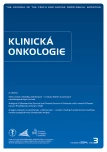Bevacizumab as Second‑line Treatment of Glioblastoma – Worth the Effort?
Authors:
R. K. Rovere
Authors‘ workplace:
Oncology Unit, Santo Antonio Hospital, Blumenau, Santa Catarina, Brazil
Published in:
Klin Onkol 2014; 27(3): 219-220
Category:
Short Communication
Overview
Objective:
To evaluate the role of bevacizumab and irinotecan as second‑line treatment of glioblastoma in patients with progression after radiotherapy and temozolomide.
Methods:
A retrospective analysis of 16 subjects was performed with overall survival and toxicity evaluation as the primary endpoint.
Results:
The analysis revealed serious toxicity of this highly expensive regimen without proving an improvement in overall survival of patients in comparison to a control group.
Conclusion:
Unless there are robust data from phase III clinical trials, including quality of life assessments or evaluation of predictive biomarkers to guide therapy, bevacizumab and irinotecan regimen should be spared for cautiously selected patients, especially in countries with limited budget for oncological treatment.
Key words:
glioblastoma multiforme – treatment – targeted agents – bevacizumab – overall survival
Glioblastoma multiforme is one of the most aggressive human cancers, associated with significant neurological morbidity and very poor survival rates [1].
It was almost a decade ago when temozolomide combined with radiotherapy, became established as a standard of care for patients who underwent a surgery for glioblastoma [2], yielding a two‑month increase in overall survival compared to radiotherapy alone.
Latest phase II studies with bevacizumab as a single agent or in combination therapy with cytotoxic agents such as irinotecan in patients with grade 3 and grade 4 malignant gliomas [3,4] demonstrated a significant clinical response, leading to its subsequent approval by the FDA [5].
A total of 16 patients from our oncologic unit, with a histologically documented grade 4 glioblastoma multiforme were evaluated. All of them received temozolomide as first‑line treatment in combination with radiotherapy, and subsequently experienced disease progression to an unresectable stage, considered either as radiological progression or clinical status deterioration. The median age was 62 (ranging from 43 to 78 years of age) and these patients were eligible for further therapy with irinotecan and bevacizumab. The median number of administered treatment cycles was 7 (ranging from 2 to 12)and the median overall survival of patients receiving a second‑line treatment was 5.2 months (from 0.8 to 9 months), without any significant difference in comparison to patients receiving best supportive care [6]. The toxicity of this treatment in this particular subset of generally very ill patients is also a matter of concern. Among the main adverse events we noted three intracranial haemorrhages, four cases of newly diagnosed severe hypertension and two bowel perforations. The overall cost of managing adverse effects of the treatment were relatively high, not to mention the drug‘s high price.
Other trials involving other VEGF inhibitors have also failed to prove its benefits in this type of tumour [7], some of them suggesting lomustine as a control arm in future post temozolomide progression trials [7].
We are aware of the fact that the study population of our retrospective analysis is too small to draw conclusions concerning the adoption of a certain regimen as a standard of treatment, yet, it provides a reference that should not be neglected.
We strongly believe that, at least while there are no robust phase III trials with quality of life assessments, since we unfortunately do not have any predictive biomarker to guide therapy, the bevacizumab + irinotecan scheme should be very carefully used, if ever, in well selected patients, especially in limited cancer budget countries.
The authors declare they have no potential conflicts of interest concerning drugs, products, or services used in the study.
The Editorial Board declares that the manuscript met the ICMJE “uniform requirements” for biomedical papers.
Rodrigo Kraft Rovere, MD
Oncology Unit
Santo Antonio Hospital
Rua Itajaí 545
Blumenau, Santa Catarina
CEP 89050100 Brazil
e-mail: rodrigorovere@hotmail.com
Submitted: 6. 4. 2014
Accepted: 12. 4. 2014
Sources
1. Stupp R, Hegi ME, Mason WP et al. Effects of radiotherapy with concomitant and adjuvant temozolomide versus radiotherapy alone on survival in glioblastoma in a randomised phase III study: 5‑year analysis of the EORTC ‑ NCIC trial. Lancet Oncol 2009; 10(5): 459 – 466. doi: 10.1016/ S1470 - 2045(09)70025 - 7.
2. Stupp R, Mason WP, van den Bent MJ et al. Radiotherapy plus concomitant and adjuvant temozolomide for glioblastoma. N Engl J Med 2005; 352(10): 987 – 996.
3. Kreisl TN, Kim L, Moore K et al. Phase II trial of single‑agent bevacizumab followed by bevacizumab plus irinotecan at tumor progression in recurrent glioblastoma. J Clin Oncol 2009; 27(5): 740 – 745. doi: 10.1200/ JCO.2008.16.3055.
4. Friedman HS, Prados MD, Wen PY et al. Bevacizumab alone and in combination with irinotecan in recurrent glioblastoma. J Clin Oncol 2009; 27(28): 4733 – 4740.
5. Cohen MH, Shen YL, Keegan P et al. FDA drug approval summary: bevacizumab (Avastin) as treatment of recurrent glioblastoma multiforme. Oncologist 2009; 14(11): 1131 – 1138. doi: 10.1634/ theoncologist.2009 - 0121.
6. Brem H, Piantadosi S, Burger PC et al. Placebo ‑ controlled trial of safety and efficacy of intraoperative controlled delivery by biodegradable polymers of chemotherapy for recurrent gliomas. The polymer ‑ brain tumor treatment group. Lancet 1995; 345(8956): 1008 – 1012.
7. Batchelor TT, Mulholland P, Neyns B et al. Phase III randomized trial comparing the efficacy of cediranib as monotherapy, and in combination with lomustine, versus lomustine alone in patients with recurrent glioblastoma. J Clin Oncol 2013; 31(26): 3212 – 3218. doi: 10.1200/ JCO.2012.47.2464.
Labels
Paediatric clinical oncology Surgery Clinical oncologyArticle was published in
Clinical Oncology

2014 Issue 3
Most read in this issue
- Very Late Effects of Radiotherapy – Limiting Factor of Current Radiotherapy Techniques
- Inverted Papiloma and Its Rare Forms
- Cancer in Elderly
- Bevacizumab as Second‑line Treatment of Glioblastoma – Worth the Effort?
